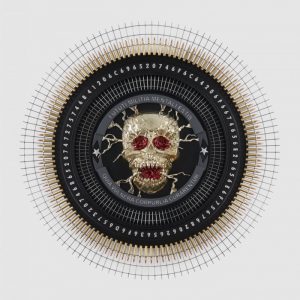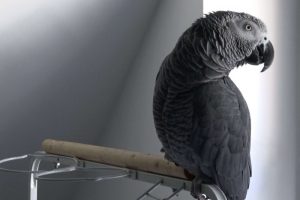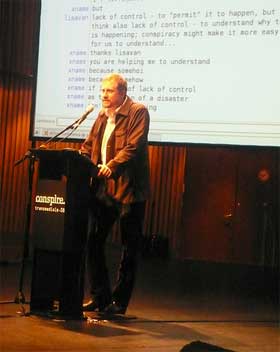 The talk i was looking forward to listen to during the Transmediale conference last week was Trevor Paglen‘s who was part of Session 4: Techno-Historical Collusions: The Making Of A Trojan Horse.
The talk i was looking forward to listen to during the Transmediale conference last week was Trevor Paglen‘s who was part of Session 4: Techno-Historical Collusions: The Making Of A Trojan Horse.
(Previously, in the same session: Eva Horn’s talk at Transmediale)
Paglen works at the border of art and research and is currently completing a PhD in the Department of Geography at the University of California at Berkeley. His artistic work deliberately blurs the lines between social science, contemporary art, and other more obscure disciplines in order to construct unfamiliar, yet meticulously researched ways to interpret the world around us. He has published two books (Torture Taxi: On the Trail of the CIA’s Rendition Flights (Amazon USA and UK) which documents the use by the CIA of modified commercial aircraft for extraordinary rendition; and I Could Tell You But Then You Would Have to be Destroyed by Me (Amazon USA and UK) about the secret world of military imagery and jargon revealed by patches from classified projects) and is currently preparing the third one (Blank Spots on a Map, 2008/09).
One day Paglen arrived at his office to find man standing in front of his door, looking with intensity at a picture hung outside of the office. At some point, the man tried to pick out the image out of its frame. Paglen intervenes and asks him what he think he’s doing. The guy then asks him “Do you know what that place is?” Starts a dialog where the man reveals that he used to be a pilot. He and his companions at the army were instructed that there were places in the desert where they would not be able to fire at all, where they could not land under any circumstance. One of these places was just called “The Box”. But one of the pilots ran out of gas and has no choice but land on “The Box.” A week later, the guy comes back. He wouldn’t say anything. “That place belongs to the Black World.” The black World, as military insiders call it, is the world of classified programs, projects, and places, whose outlines, even existence, are deeply-held secrets.
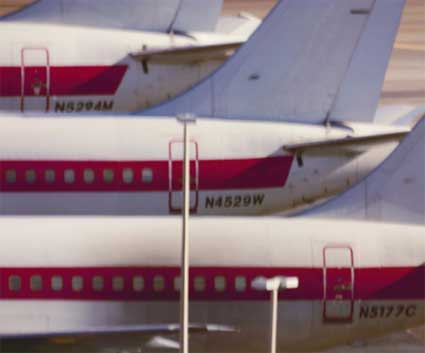 Tail Numbers/Gold Coast Terminal, Las Vegas, NV/Distance ~1 mile/5:27 pm
Tail Numbers/Gold Coast Terminal, Las Vegas, NV/Distance ~1 mile/5:27 pm
Paglen then showed us pages from the Department of Defense Budget Fiscal Year 2008. The document is publicly available but presents some puzzling numbers. For example, a whopping $ 12.3 million is allocated to toilets which, the document states, must provide soldiers with equipment 2 enhance their efficiency and efficacy.”
Paglen showed more images from a documents of classified strategic RDT&E programs. Some projects with mysterious names such as “Pilot Fish”, “Retract Juniper,” “Chalk Coral”, etc. receive huge budget but, unlike the toilets do not present any justification. Sometimes the sum allocated to a project does not appear at all, leaving blank spots in the budget. The National Security Agency has mostly blanks in its budget.
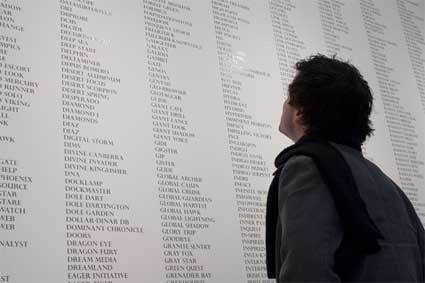 Code Names: Classified Military Programs Active Between 2001 and 2007
Code Names: Classified Military Programs Active Between 2001 and 2007
One of Paglen’s work inspired by the military budget is Code Names is a list of words, phrases, and terms that designate active military programs whose existence or purpose is classified.
So what happens with these “Selected Sites Associated with Classified Military Activity”? Money doesn’t disappear like that. Paglen calls them the “Black Dollars”. A number of places where these figures congeal are located in the South West of the country, more precisely in the desert. That area has a long history of being an unexplored region. In World War II, these places became useful to hide secret bases where airplanes were tested. Also the Manhattan Project in 1945.
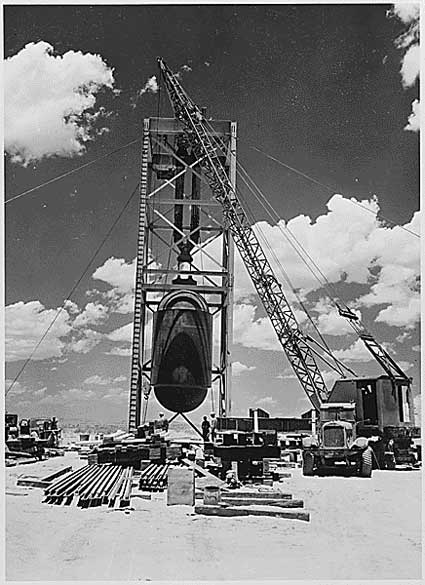 Manhattan Project, “Jumbo” atomic device being positioned for “Trinity” test at Alamogordo, New Mexico (souce)
Manhattan Project, “Jumbo” atomic device being positioned for “Trinity” test at Alamogordo, New Mexico (souce)
This Black World started to get more importance in the ’80s. The Black Budget became then a big part of the defense budget with President Reagan, a man fascinated by secret weapons.
Paglen showed more documents to prove his point.
The next issue he tackled was “How do we study something that doesn’t exist? Something that must stay hidden?”
Paglen turned to geography to make emerge a negative image of these black spots on maps. That’s where he compares his work to the one of an astronomer because he deals with dark matters, with phenomena which are detectable only through the influence they exercise on the visible world.
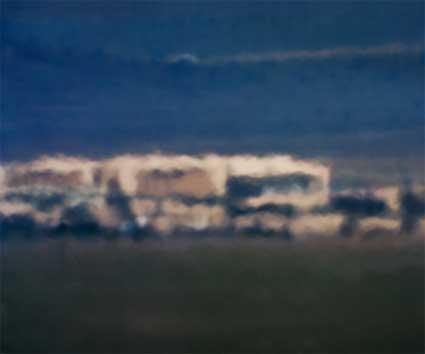 Open Hangar/Cactus Flats, NV/Distance ~18 miles/10:04 am
Open Hangar/Cactus Flats, NV/Distance ~18 miles/10:04 am
He uses similar instruments as astronomers’ to create his Limit Telephotography series.
Many of the military bases and installations hidden deep in deserts and buffered by dozens of miles of restricted land are so remote that a civilian might be able to see them with an unaided eye. In order to visually document these places, Paglen uses high powered telescopes whose focal lengths range between 1300mm and 7000mm. At this level of magnification, hidden aspects of the landscape become apparent. Because of the distance and the heat coming off the desert, these images have peculiar aesthetical qualities that sometimes evoke impressionists paintings rather than photography.
Limit-telephotography resembles astrophotography, a technique that astronomers use to photograph objects that might be trillions of miles from Earth.
Flight Tracking
CIA sets up civilian front companies to hide these “black” operations, making it look like a normal business. But even front companies must produce flight logs, registration papers, and other legal documents. And most of them publicly available. That’s the kind of data you check to know if a plane will land on time for example. Now how do you find front companies? Documents such as the Civil Aircraft Landing Permits lists the planes which are allowed to land on military landfills. These are companies you have never heard of. You can get a list of the planes these airlines own and from there track information about where they land and from where they fly.
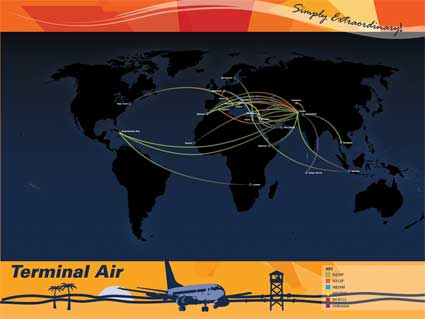 Terminal Air
Terminal Air
Terminal Air, a visualization system that Trevor Paglen developed together with the Institute for Applied Autonomy tracks the CIA aircrafts. You can register and get an email message when a CIA plane is coming to your city.
These companies leave other traces. They must have addresses. One of them lead Paglen to a law office which is weird for an aviation company. No one would answer his questions. Then there are signatures at the bottom of documents belonging to the companies. He deciphered the names and found individuals which, unlike the rest of us, leave no electronic trace: they have no credit history, no driver license, etc. They all have a single address which is a PO Box in Virginia. Paglen went there and discovered that the PO Box was used by hundreds and hundreds of names. It’s a long collection of ghosts, of fictional characters. Which makes sense as these people are in the business of making other people disappear.
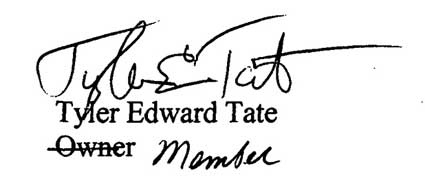 Signature of a non-existing airline company member (image source)
Signature of a non-existing airline company member (image source)
Paglen also practices some Amateur Anthropology.
These people involved in secret activities have colleagues which are the only persons with whom they are allowed to talk about their jobs. They organize reunions and form bonds. They also give awards to each other but they can’t exactly say what this award is for. So someone would get an award for his or her “significant contribution in a remote location.”
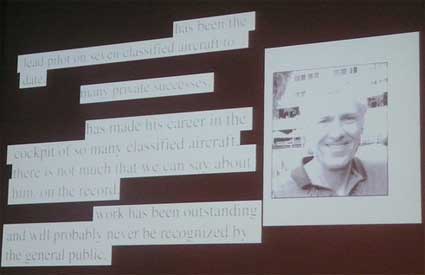 One of Paglen’s slides showing the cryptic information of someone involved in one of the secret programs he’s investigating
One of Paglen’s slides showing the cryptic information of someone involved in one of the secret programs he’s investigating
Paglen is also into Amateur geo-spacial intelligence. He and his collaborators make maps of the world based on those flights.
He then reminded us of the case of Khalid El-Masri, a German citizen who was abducted, flown to Afghanistan, interrogated and tortured by the CIA for several months in one of those Black Sites and then released without charge. The extrajudicial detention was apparently due to a mis-spelling of El-Masri’s name. When the CIA realized El-Masri was the wrong guy, they threw him on another plane and freed him in Albania.
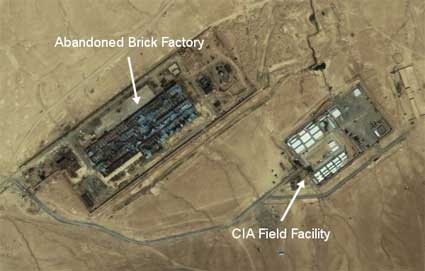 Aerial view of Salt Pit (image)
Aerial view of Salt Pit (image)
It is believed that the jail were he was detained was a secret CIA detention center outside Kabul called the Salt Pit. For five months, El-Masri says, he was locked in a solitary cell in the Salt Pit and interrogated by Arabic-speaking inquisitors who asked him repeatedly if he was involved with the Sept. 11 hijackers, if he’d journeyed to Jalalabad on a false passport, if he hung out with Islamic extremists living in Germany (via).
Symbology.
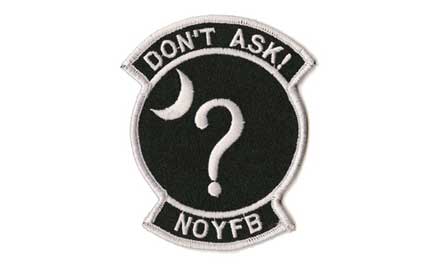 NOYFB. Fabric patch, Edition of 50, 2006
NOYFB. Fabric patch, Edition of 50, 2006
Military have all sorts of patches, icons and insignia. They reveal anything that they do or are. These markers of identity and program heraldry begin to create a peculiar symbolic regime when they depict one’s affiliation with what defense-industry insiders call the “black world”.
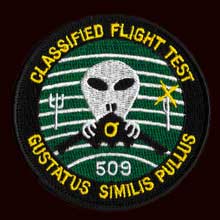 The symbols and insignia shown in Paglen’s Symbology series provide a glimpse into how contemporary military units answer questions that have historically been the purview of mystery cults, secret societies, religions, and mystics: How does one represent that which, by definition, must not be represented?
The symbols and insignia shown in Paglen’s Symbology series provide a glimpse into how contemporary military units answer questions that have historically been the purview of mystery cults, secret societies, religions, and mystics: How does one represent that which, by definition, must not be represented?
Both the icons and words used on the patches are weird. “Alone and on the Prowl”, sometimes with inside jokes “Gustatus Similis Pullus” (Tastes Like Chicken); “Doing God’s works with other people’s money,” NOYFB (None of Your Fucking Business), etc.
You can see some of these patches until February at the Transmediale exhibition which runs until February 24 at the House of World Cultures in Berlin.
Related: Interview with the Institute for Applied Autonomy; Tracking the Torture Taxis; The Captives.

